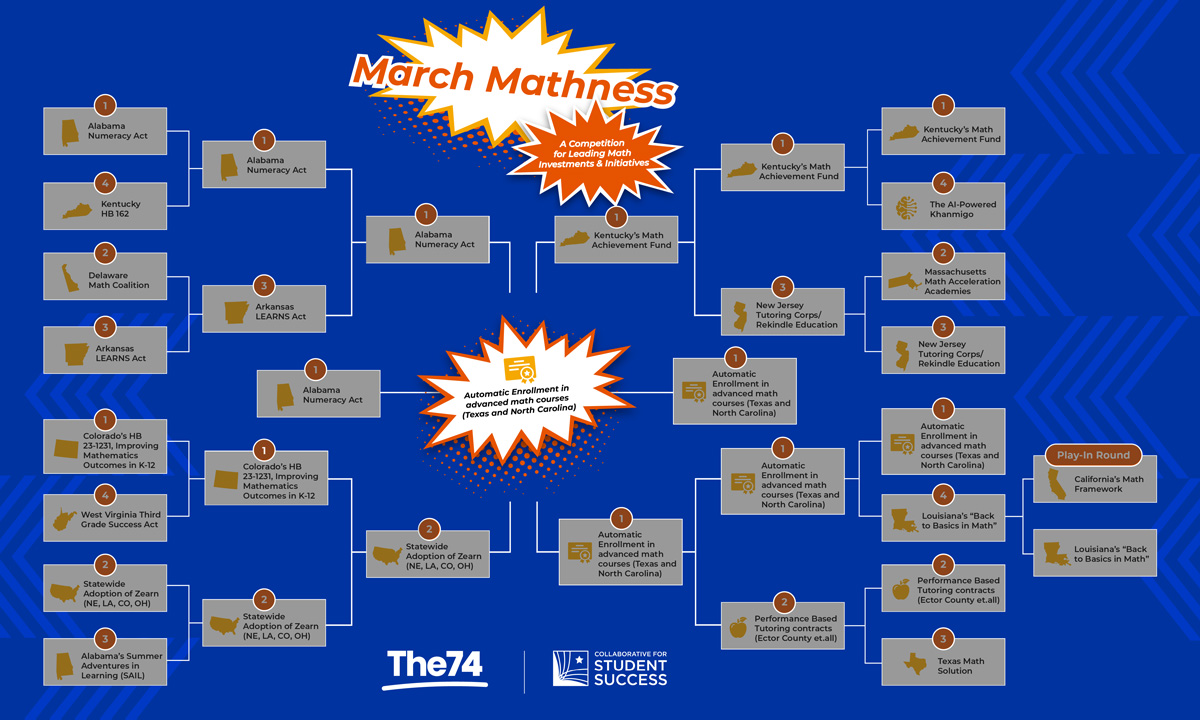Game-Changing Automatic Enrollment Policies Win Our March Math-ness Bracket
Cowen: All innovative contenders in our alternate tournament are leading efforts to advance math education and boost learning in states and districts.

Get stories like this delivered straight to your inbox. Sign up for The 74 Newsletter
Millions of college sports fans have filled out their NCAA March Madness brackets. They’ve calculated their favorite team’s chance of claiming the championship. They’ve weighed statistics and track records to determine no-brainers and upsets. And many have celebrated or lamented as they’ve been met with early wins or losses that either validated or busted their data-informed brackets.
In short, America is doing a lot of math — at a time when math achievement is experiencing historic challenges.
Enter the March Mathness tournament, an NCAA-style competition hosted by the Collaborative for Student Success to spotlight state and district initiatives that are helping kids catch up and accelerating learning in math.
With the goal of bringing attention to innovative efforts transforming how math education is delivered in schools, we’ve convened a plucky panel of three expert judges, each with their own critical lens on K-12 education policy.
Chad Aldeman writes for EduProgress and The 74 and formed his March Mathness bracket by evaluating each program for strong implementation, scalability and evidence. Jocelyn Pickford, writing for CurriculumHQ, weighs the contenders with eyes focused on the use of high-quality instructional materials and meaningful teacher and family engagement. AssessmentHQ’s Dale Chu rounds out the judges’ table with a focus on responsible use of data and strong student outcomes.
The tournament began with a Sweet Sixteen lineup representing a diverse range of approaches to improving math achievement. From statewide comprehensive reforms in states like Alabama, Kentucky, Arkansas and Colorado to the widespread use of innovative learning platforms like Zearn and the AI-powered Khanmigo, the tournament narrowed to an Elite Eight. Three state bills and the use of Zearn across four states advanced alongside novel tutoring approaches from Texas and New Jersey, a policy of automatic enrollment in advanced math courses out of North Carolina and Texas, and a statewide math fund in Kentucky focused on professional learning and coaching.
The competition heated up in the Final Four. Alabama’s Numeracy Act — a comprehensive set of reforms that provide elementary math tutors, set up a process for vetting and approving evidence based, educator-reviewed math curriculum, and transform teacher training and preparation — challenged the statewide use of Zearn in Nebraska, Louisiana, Colorado and Ohio. Zearn proved its worth throughout the bumpy road of pandemic-era schooling, when multiple states provided free, universal access to its digital learning platform to supplement instruction and enable kids to access evidence-based instruction both in school and remotely.
Despite impressive evidence that shows gains on state math assessments for students who use Zearn consistently, the multi-faceted approach of Alabama’s Numeracy Act, and its standing as a nationwide exemplar of proactive math legislation, fueled its advance to the finals.
The second matchup of the Final Four saw Kentucky’s Math Achievement Fund go toe-to-toe with a novel automatic enrollment policy out of North Carolina and Texas. Kentucky’s Fund is one of the longest-standing initiatives in the competition, dating from 2005. It provides grants to schools and districts for math coaches, high-quality materials and extra professional development. With nearly 20 years of outcomes data, the fund has strong evidence of having moved the needle for Kentucky students in grades K-3.
Meanwhile, North Carolina and Texas have been garnering nationwide attention for new statewide policies meant to increase enrollment in advanced math courses. Students who score at the highest levels on the state math test are automatically enrolled in advanced classes for their next school year, turning on its head the long-held practice of having them opt in. Now, high-achievers must opt out, a move many advocates describe as game-changing.
Begun in Dallas Independent School District before being taken statewide in Texas, the policy saw a doubling in the percentage of students of color enrolled in advanced math. In North Carolina, the new process has resulted in a steadily increasing number of high-achieving students enrolling in advanced courses — and sticking with them — as they work toward additional college and career opportunities. While Kentucky’s Math Achievement has been moving the needle for two decades, automatic enrollment policies are making a big wave — enough to cinch the W in this round.
As for the championship match, the battle for the March Mathness title could not have been fiercer.
The judges fought passionately to decide between the heavyweight Alabama Numeracy Act and the newcomer automatic enrollment policies in Texas and North Carolina.
Pickford was a stalwart defender of Alabama, applauding the Numeracy Act as a national standout for state leadership in promoting instruction rooted in evidence-based curriculum and wraparound supports for students, families and teachers. “Any state effort to advance learning should be rooted in access to and use of materials that are aligned to a state’s academic standards, have been endorsed by educators and empower teachers to reach all students. As leaders consider the March Mathness practices for their states or districts, I urge them to place evidence-based instruction and educator and family engagement at the center.”
Chu and Aldeman, while agreeing with Pickford about the merits of Alabama’s legislation, underscored the ripple effects of a move like Texas and North Carolina’s new process. “Automatic enrollment policies in advanced math courses represent a sea change in the way we think about math opportunities for students. After decades of requiring students to opt themselves into higher-level courses, widespread adoption of this kind of policy would represent a raising of expectations for students, rather than treating advanced math as a ‘nice-to-have’ for only some kids,” the pair said.
Ultimately, the judges decided, the relative simplicity of automatic enrollment — and the ease with which other states could adopt this for their K-12 systems — catapulted Texas and North Carolina to a winning slam-dunk.
Though automatic enrollment ultimately took home the championship, the full March Mathness bracket showcased a wealth of strategies that states and districts are employing to advance math education. From digital platforms and summer learning to professional development and comprehensive legislative reforms, the variety of initiatives reflects a nationwide commitment to improving math outcomes for all students.
The success of the March Mathness tournament lies not just in crowning a champion, but in highlighting the innovative and varied efforts underway to tackle the challenges in math education in the United States.
Looking ahead, the Collaborative for Student Success will continue to shine a light on the most promising efforts to advance math learning, and will urge states and districts to learn from the past four years of academic recovery as they weather challenges posed by the expiration of federal relief dollars, record chronic absenteeism and the continuously changing needs of students and families.
We hope you enjoyed March Mathness — but the math fun doesn’t end there. Stay connected with our math efforts and learn more about how you can help advance a renewed focus on math education on our EduProgress platform. We’ll see you next year for the Big (Math) Dance!
Get stories like these delivered straight to your inbox. Sign up for The 74 Newsletter

;)
